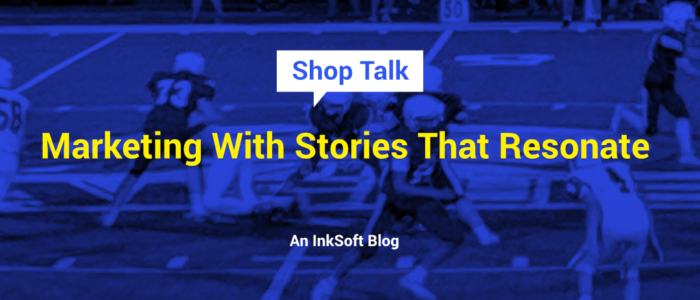If there is one thing that I know that works in marketing, telling a story is at the top of the list. As people, we are naturally attracted to wanting to dig deep and learn and a good story sometimes is irresistible.
Facts are boring.
How something works or the fact that the consumer saved enough money to buy a trip to New Zealand is more interesting.
What Stories Can You Tell?
This might seem a little daunting. After all, it’s not like you are a professional writer or anything. Yet, you tell stories constantly to your friends and family.
It’s just like that.
Only now, it’s about one of your customers. Grab a pen and a notepad and jot down a few instances where this happened:
In this story, they are the hero. They needed your help because:
- They had a tight deadline or an emergency. You saved their butt!
- You heard them say, “Hey I can’t even draw a straight line!” – Your creative genius came shining through.
- Someone had a gigantic need to raise money. Your shirt program helped achieve that goal, and then some.
- After using other shops that missed deadlines or shipped an inferior product they found you. Now, life is good.
- Their boss gave them the task of ordering shirts for the event. Your expertise was the guiding light that made them look great!
Do any of these sound familiar? I’ll bet they do. I’ll bet you know a few more.
These stories resonate because there are other people out there that have these same problems. Trust me, I didn’t make these up for this article.
I’m curious. Did you come up with a few examples?
Using These Stories
This stuff is gold.
The absolute best is to get your customer to share that tale. That turns that hero story into a social influencer. Whatever you do or say is one thing, but if a customer tells the same tale it is a hundred times more powerful.
Think about all the ads you’ve consumed over the years that may have “actual users” talking about how that product changed their life in some way. That’s the reason those ad geniuses show that. When you see customers raving about a new car, laundry detergent, or tasty pizza, you are more likely to buy one yourself.
That connection is made on a deep level.
And if somehow that connection is made with a strong emotion?
Bingo!
That’s the ties that bind.
Stories With Video
A video is the most powerful tool in your toolbox.
It’s visual, so we can see whatever is in the video and relate to it. Can you show your absolute craftsmanship? Will your creativity stand out? Can you get your customer to hold up their shirts, smile and tell everyone how incredibly awesome you are to work with?
You can share this on your website, Instagram, Facebook or other social media channels. If your video speaks from the heart and tells a great story it will get shared numerous times. This exponentially drives more engagement that when you share it yourself.
That’s the social proof that what you do is working.
Stories With Pictures
They say “a picture is worth a thousand words”.
If that’s true, then how many images have you been sharing lately? What stories are you telling with yours?
Capture the moment when your customer opened that box and saw your creativity shine. Get the team to share pictures of them celebrating the win. You want to illustrate folks using your product.
But don’t stop there.
Get a quote or something on the image from your customer. A “These guys are the best” statement, or how you helped solve their problem in a few words.
Remember, you are storytelling.
Your goal is to have other customers just like this one, think to themselves, “Hey, I need them to help me with my shirt program.”
Stories With Words
Can tell a joke?
No, not like a professional comedian. But with your friends. Can you tell an amusing story over a cup of coffee or a beer?
Probably.
If you can do that, you can write. Writing is simply telling stories.
Your hero customer has a problem. They turn to you because you are the guide that is going to help them. You have a plan. If they accept the plan they win. Disaster looms if they don’t.
That’s the story you can tell.
Put that into your marketing copy for advertising. Write that up as a blog article. Submit that to the local newspaper as a press release.
You Got This
I know it may seem daunting to start down this path. However, I’ll bet with a little effort, a dash of creativity, a pepper of humor, and some good ol’ fashioned effort your marketing collateral can improve by using stories.
Frame things in the context that your customer solved a big problem by using your shop.
There are people out there with that same problem. You want that alignment and connection.
Stories demonstrate and prove your value to potential customers.
Get busy!


